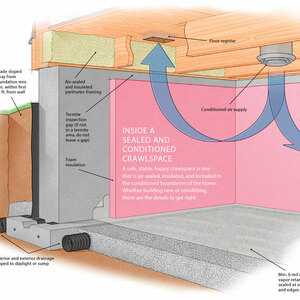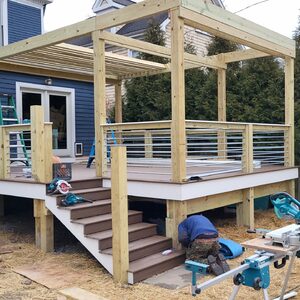*
I am building a 16’x 20′ garden shed for a client who is budget minded. As a result, I am using vinyl siding and fiberglass architectural shingles. However, the client wants a quaint and classy looking building as the finished product.
Does anyone have suggestions for design details that would help our shed have the desired distinction?
Here are the current shed specs: 16’x 20′ building, 9’x 7′ overhead door centered on one eve wall, small decorative cupola, 36″x40″ window with shutters on each gable wall
I am considering a possible dormer over the entry, 1/2 round vents in the gables, multi-piece decorative corners and casings and flower boxes on the windows.
Has anyone built something like this? What did and didn’t work.


















Replies
*
Hi Jon. We're in the process of building one 16' x 24'. My recommendation is that 'quaint and classy' and 'vinyl siding' are not commensurate. The more details (like louvers, decorative casings, etc.) you use the clearer it will be that the plastic siding doesn't belong.
Our shed takes period details from the house, does have a small dormer over the entry door and has 'barn' doors instead of overhead.
Don't make the cupola too small - a good rule of thumb is 1" wide per 12" of ridge, so it should be at least 18-20" on a side, if not more.
I've made beaded (5/8" bead) corner boards for ours and it will have drop siding (wood) as well as reclaimed/restored windows and door from the 1930's.
Jeff
PS - As an aside, if double-hung the windows seem a bit 'squarish' to me for quaint - unless you have them already you might want to consider something better proportioned to a shed (and to traditional lites) like 32" x 60". Use real wood shutters and hang on pintles (yes, that is a cost consideration).
*Gee Jeff...why not dip it in gold? Budget minded?? Jeff
*Jeff, everyone has a budget now, don't they?Jeff
*Suggestions:- Reconsider the vinyl siding (as Jeff #1 says), better to spend more here and upgrade the rest over time; once that vinyl goes on, it will look cheesy for decades. Maybe a cedar shingle that you can let weather (no paint saves $); maybe the client can be persuaded to inject some sweat equity into this task, adding a shingle diamond or two for accent. I think shiplap has a nice crisp informality to it. Plywood w/battens or even T-111 would be better than vinyl.- Use nice fat trim.- A trellis here & there is always appropriate on a garden structure.- Let the plants do the talking, keep the building in a supporting role. Put plants with a tall arching habit (e.g. lilac, beauty bush) near the door to extend the sense of entrance.
*I had the same thing going. I decided to use the vinyl and go with wood corners and trim, packed out to allow the vinyl to slide behind it all. I used a low sheen siding and its tough to tell its vinyl withpout touching. I trimmed so there would be no seams in the vinyl. As far as up keep goes on the wood trim its easy to repaint because you can slide some tar paper behind the trim and don't have to worry about over spray on the vinyl. I also used phypon details on under the soffits and fencing along the front of the shed on both sides of the door. These areas left two nice spots for small gardens.
*This lovely shack is on the cover of Family Handyman, June issue. All drawings included, material list, procedure...
*splinter....There is a fine line between garden shed and second home. That is rather nice for a "garden shed".I just built one from a kit.....now that I've done one I don't think I would need to waste the extra money on the kit. Came out nice though.....not like that thing though.SJ
*Ditto Jeff C. & Lars. Adding details to a vinyl-sided outbuilding will just look cheesier the more you add. A simple building with natural siding will have much more character than a plastic building with lots of add-ons. Just my 2 cents.Mike
*Lose the vinyl!
*Jon - What is the house sided in? What style is the house? How close to the house is the garden shed? How is the yard landscaped? Is this buidling really for gardening (ie. starts from seed, potting, rooting, etc.) or more for storage?
*Here's the back of our garden shed. The roof, under the tin, is of recycled joists and subfloor. The shed is on a dry site and has only PT shoes that sit on a rectangle of perimeter rocks. The posts that support the kennel-eave are PT re-coated with Termin-8 and set in concrete and serve as a downwind anchor. The shakes are all well protected by overhangs and aspect. The board and batten is of 1x (actual,) and is approx. 1/4" proud of the cedar top strip. The trim is penstemon purple.
*ooohhhhh, aaaaahhhhhh!
*Garden sheds provided material for a number of articles in the do-it-yourself magazines over the years. In addition to the Family Handyman there were a number of others that have arisen and folded over the years (the various titles escape me). If your client has more time than money or ideas, perhaps he or she could be pursuaded to spend some time at the local library going through their old stacks of homeowner/handyman/do-it-yourself magazines.
*Folks,One day I was in an absurd mood and put a Greek revival style portico on my R-111 shed. Really, its just a few composite mouldings and a little fluteing. It is a little silly, but sort of fun.Frank
*
I am building a 16'x 20' garden shed for a client who is budget minded. As a result, I am using vinyl siding and fiberglass architectural shingles. However, the client wants a quaint and classy looking building as the finished product.
Does anyone have suggestions for design details that would help our shed have the desired distinction?
Here are the current shed specs: 16'x 20' building, 9'x 7' overhead door centered on one eve wall, small decorative cupola, 36"x40" window with shutters on each gable wall
I am considering a possible dormer over the entry, 1/2 round vents in the gables, multi-piece decorative corners and casings and flower boxes on the windows.
Has anyone built something like this? What did and didn't work.